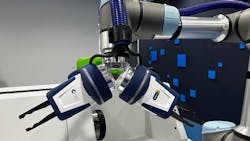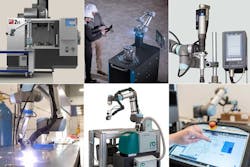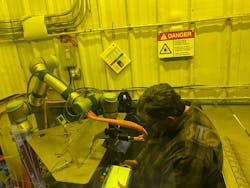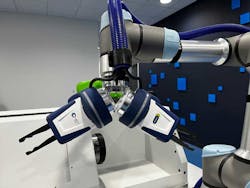Welding Cobots are the New Hired Guns
At a Glance:
- Universal Robots made an impression with more than 30 applications at Automate 2022, North America’s largest AI and robotics showcase.
- Cobots are an essential tool in the machine builder’s arsenal in combating the skills shortage, according to Joe Campbell, Universal Robot’s head of strategic marketing for North America.
- The UR booth featured MIG, TIG and laser welding demos.
The American Welding Society estimates that the U.S. will need more than 336,000 welders to meet industry demand by 2026.
Yet, if fabricators look to welding robots as a remedy and welding professionals worry that collaborative robots (cobots) will steer jobs into obsolescence, economists argue, there may very well be a disconnect from the host of possible trajectories that could emerge from adopting automation technologies.
Across industries, economists generally predict less dire outcomes for the rise of robots. They argue instead that the impacts of the skills shortage—such as decisions on automation, new production and outsourcing—are more likely to result in a mixed picture supported by decisions made by individual company owners and new types of jobs. Cobots, in particular, are intentionally built to cooperate; they augment tasks with precision, strength and efficiency, all the while working alongside humans in a common workspace.
As an application trend, however, the demand for cobot welding can be attributed to “an understanding from companies that their customer base is desperate for modest costs, quick-to-deploy, fast return on investment solutions,” according to Joe Campbell, Universal Robot’s head of strategic marketing for North America.
“You can’t hire welders to 85,000 job openings for skilled arc welders right now—it’s a big problem,” Campbell said during a booth interview at Automate 2022 (June 6-9). “We’re hearing about it in every market segment, from machine tending to palletizing. All these jobs that are either dull, dirty or dangerous, or a combination of those, are difficult to hire for anyway.”
READ MORE: Automate 2022: Machine Vision Solutions Point to the Future of Automation
Cobot Welding Market Traction
UR’s cobot welding segment grew an astounding 300% in 2021 compared to 2020 levels. “What’s interesting is three years ago this was nothing,” said Campbell. “It was just a handful of units in our volume. We’re projecting this year it will be over 10% of our total volume.”
Efforts to emphasize cobot welding were on full display at Automate 2022, where UR’s booth welding demonstrations included MIG, TIG and laser welding demos. Cobot Systems, a UR Certified Systems Integrator (CSI), launched the first commercially available IPG LightWELD laser welder that is guided and controlled by a UR cobot.
Another solution, the UR CSI Melton Machine and Control Co., was an enhanced version of the market’s first cobot-powered cold wire feed TIG welder. The system enables the cobot to add both fusion and filler material to thinner material as it travels and can be used in a variety of applications, such as exhaust systems on motorcycles or kitchen sinks. Melton Machine’s website notes that anyone with little to no experience can learn to program the robot within minutes.
Bundle up for New Applications
Campbell, a robotics industry veteran, noted that companies are electing to latch their welding processes to UR’s architecture. “In our philosophy, we have two layers of software,” he explained. “The upper layer is a deployment layer, so it’s easy for people to take our products and deploy them. It’s easy to teach, it’s easy to make basic programs and to set up basic logic. Underneath that, we have an open architecture API. If you are a developer of a heavy development machine, that is where you’re going to work to build your specific functions for your process.
UR releases four significant software releases per year. This is a little-known but noteworthy detail, said Campbell, because UR collaborates with more than 400 third-party companies. “Almost all of them have a heavy software component,” he said. “It is how we drive all these new features that enable the new applications.
RELATED
Cobotization: The New Reality for Farmers
Applied Cobotics Integrates Robotics With Other Functions
Aside from welding cobots, UR could boast that its technologies were located at 30 applications around the show. “We’ve got 11 different applications, from metal fab and machine tending to assembly and quality to packaging and palletizing,” said Campbell.
Automate attendees could look to Kane Robotics for an example. The Calif.-based automation and integration company focuses on the aerospace and defense industry and showcased cobots integrated with torque sensing that enable sanding and polishing of propellor blades. A force sensor attached to the cobot’s end effector (ATI Industrial Automation’s AOV-10 Robotic Orbital Sander) facilitates the use of force control to achieve consistent surface finishing with an orbital sanding tool.
In another application, end-effector and gripping solutions provider Schunk demonstrated how electric two-finger parallel grippers (EGP-C) attached to a UR5 could move small components through Schunk’s material removal tool. A deburring brush can complete deburring tasks between loading and unloading.
About the Author

Rehana Begg
Editor-in-Chief, Machine Design
As Machine Design’s content lead, Rehana Begg is tasked with elevating the voice of the design and multi-disciplinary engineer in the face of digital transformation and engineering innovation. Begg has more than 24 years of editorial experience and has spent the past decade in the trenches of industrial manufacturing, focusing on new technologies, manufacturing innovation and business. Her B2B career has taken her from corporate boardrooms to plant floors and underground mining stopes, covering everything from automation & IIoT, robotics, mechanical design and additive manufacturing to plant operations, maintenance, reliability and continuous improvement. Begg holds an MBA, a Master of Journalism degree, and a BA (Hons.) in Political Science. She is committed to lifelong learning and feeds her passion for innovation in publishing, transparent science and clear communication by attending relevant conferences and seminars/workshops.
Follow Rehana Begg via the following social media handles:
X: @rehanabegg
LinkedIn: @rehanabegg and @MachineDesign



